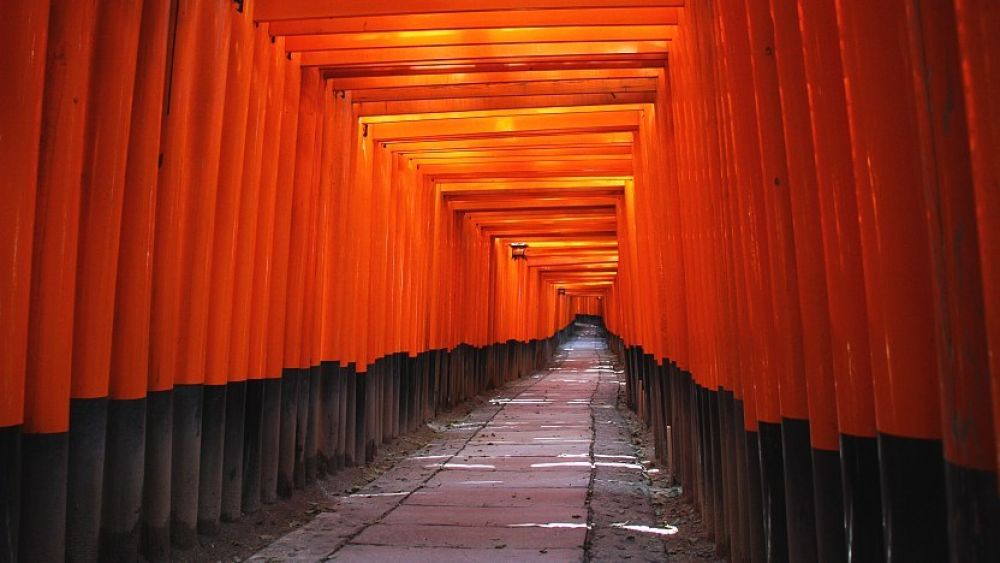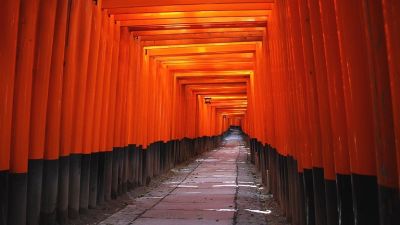

The Torii Gate Walk at Fushimi Inari Shrine is an iconic experience, providing visitors with an opportunity to stroll through thousands of vermilion torii gates that lead up the sacred Mount Inari. This mesmerizing pathway, known as Senbon Torii ('thousands of torii gates'), is a spiritual journey for many, and one of the most photographed sites in Kyoto. As you walk along the four-kilometer trail to the mountain summit, you'll encounter smaller sub-shrines, fox statues, and traditional purification springs. The fox, or 'kitsune', is considered the messenger of the Shinto deity Inari, and numerous statues are found throughout the shrine grounds, often holding a key in their mouths, symbolizing the key to the rice granary. The hike can be a meditative experience as well as an excellent opportunity for photography enthusiasts. The ascent offers various viewpoints over Kyoto, and the atmosphere changes from the spirited and busy entrance to a serene, almost mystical setting as you climb higher.
Experiencing sunrise at the Fushimi Inari Shrine offers a unique and tranquil moment, well before the crowds start to gather. This early morning activity allows visitors to enjoy the shrine in relative solitude, offering a chance to participate in the traditional Shinto customs of purification and prayer at this peaceful hour. Observing the priests and local worshipers performing their morning rituals provides an authentic look into the religious practices tied to the Ina (rice harvest), the original purpose of the shrine. The changing hues of the sky casting soft morning light on the red gates and verdant surrounds creates a spiritual ambiance. Visitors can also purchase charms, known as 'omamori', or partake in 'omikuji'—fortunes written on strips of paper. While the entire shrine complex may not be fully staffed or active, the experience of dawn at Fushimi Inari Shrine is both memorable and invigorating.
For those interested in delving deeper into the history and cultural significance of Fushimi Inari Shrine, taking a guided tour with a knowledgeable local guide can greatly enhance the experience. Guides can explain the origins of the shrine, its connection to Japanese culture, and the role it plays in Shinto traditions. During the tour, participants will learn about the symbolic meanings of the shrine's features such as the torii gates, the fox statues, and the reason behind the numerous inscriptions on the gates. Guides may also share stories and legends associated with the shrine. Additionally, visitors will get insights into the proper etiquette for visiting a Shinto shrine, including practices like purification, making offerings, and prayer rituals. This tour is not only educational but also offers a personal connection to the sacred site.
At the base of the Fushimi Inari Shrine, visitors can indulge in a variety of local foods sold by vendors. These range from traditional Japanese street food to delicacies specific to Kyoto. One can sample dishes such as 'inari sushi', rice wrapped in sweet tofu skin said to be favorite of the Inari god, and 'kitsune udon', a noodle soup topped with the same type of tofu. Other common finds include 'takoyaki' (octopus balls), 'yakisoba' (fried noodles), and 'okonomiyaki' (savory pancakes). For those with a sweet tooth, there are options like 'mochi' (rice cake) and 'dorayaki' (red bean pancake). The food tasting at Fushimi Inari Shrine is not just about savoring flavors but also about understanding the local cuisine culture. Visitors can observe how the food is prepared and interact with the vendors, gaining insights into the significance of each dish.
The Fushimi Inari Shrine provides a visually stunning setting for photography enthusiasts, ranging from amateur shutterbugs to professional photographers. With its iconic red torii gates that create seemingly endless tunnels up the mountain, the scenery is both surreal and vibrant. Photographers can capture the play of light and shadow as it filters through the gates, creating dramatic contrasts and patterns. Early morning or late afternoon are ideal times to capture softer light and avoid the crowds. Additionally, along the four-kilometer hike to the summit, there are numerous opportunities for photographing the city of Kyoto, the shrine's natural surroundings, and the smaller, intimate sub-shrines and altars. Seasonal changes, such as cherry blossoms in spring or maple leaves in fall, offer unique backdrops for beautiful imagery. Though photography is encouraged, it's important to be respectful of worshipers and rituals taking place.
Fushimi Inari Shrine hosts various festivals throughout the year, coinciding with the seasons and specific dates on the traditional Japanese calendar. One of the most significant is the 'Inari Matsuri' in May, where visitors can witness grand processions, performances, and rituals dedicated to the deity Inari. Festivals often feature 'miko' (shrine maidens) performing dances, 'taiko' drumming, and food stalls offering seasonal treats. These events provide an excellent opportunity to experience Japan's rich cultural traditions and the lively community spirit tied to Shinto celebrations. Visitors are usually welcome to observe and even participate in certain aspects of the festival. It's a unique chance to see the shrine at its most festive and to capture the deeper essence of Japanese spirituality and communal life.
A night visit to the Fushimi Inari Shrine reveals a different side of the site, with its pathways and torii gates beautifully illuminated, offering a mystical and enchanting experience. As the sun sets, the shrine's lanterns and strategic lighting accentuate the spiritual atmosphere of the complex. The fewer crowds present at night allow for a more introspective journey. It's an ideal time for those seeking a more personal connection to the site or wishing to contemplate the serene beauty in peace. While not all paths may be lit or advisable to walk at night, the main areas provide a safe and mesmerizing stroll. This experience is particularly recommended during festival periods when the shrine may have additional lights or special nighttime events.
Several art studios around Fushimi Inari Shrine offer calligraphy workshops where visitors can learn the art of Japanese writing from skilled calligraphers. These workshops typically include an introduction to the tools—brush, ink, and paper—and the basic strokes of kanji characters. Participants get hands-on experience writing characters that often include words of spiritual or personal significance. Workshops often culminate in creating a piece to take home as a souvenir, such as writing a wish or one's name in kanji. The activity not only teaches the technique of calligraphy but also offers insight into its cultural and artistic importance in Japan. Such a workshop can be an enriching complement to visiting the shrine, highlighting the beauty and depth of Japanese traditions.
Beyond the torii gates, the Fushimi Inari Shrine is surrounded by a rich forest teeming with nature trails. These trails lead to smaller shrines, graveyards, bamboo groves, and ponds. Exploring these less frequented paths offers a reprieve from the more crowded main areas and uncovers the scenic beauty and cultural relics hidden in the woods. Along the way, information boards detail the flora, fauna, and historical significance of the various landmarks. Hikers can find century-old trees and stone lanterns weathered by time, creating a sense of adventure and discovery. The contrast between the bustling city of Kyoto and the tranquility of this hillside can be striking, with vistas of the cityscape occasionally peering through the gaps in the foliage. This activity blends heritage and nature, appealing to those with an affinity for both history and the outdoors.
The Japanese tea ceremony, or 'chanoyu', is an ancient tradition that embodies grace, beauty, and tranquility, with roots deeply embedded in Zen philosophy. In Kyoto, several tea houses offer visitors the chance to experience a tea ceremony, where they can learn about and participate in this ritual. These ceremonies generally take place in a traditional setting, featuring tatami mats and a serene ambiance. Guests are guided through the steps of the ceremony, including the preparation and serving of 'matcha' (powdered green tea) and the proper way to receive and sip the tea. The host also explains the importance of each utensil and the significance of the movements performed during the ceremony. The tea ceremony is a contemplative practice that complements the spiritual nature of the Fushimi Inari Shrine, offering a moment to reflect and connect with Japanese cultural identity.
